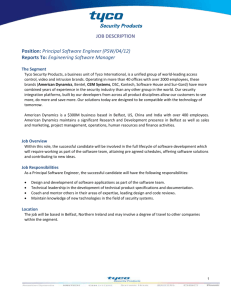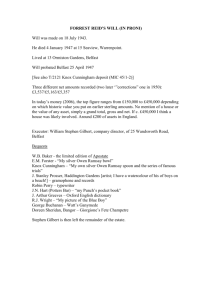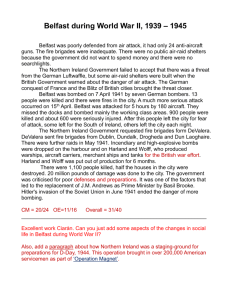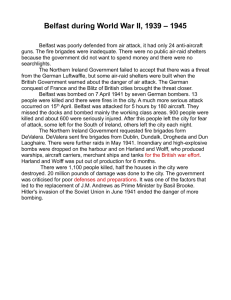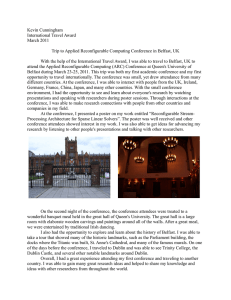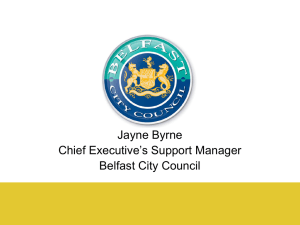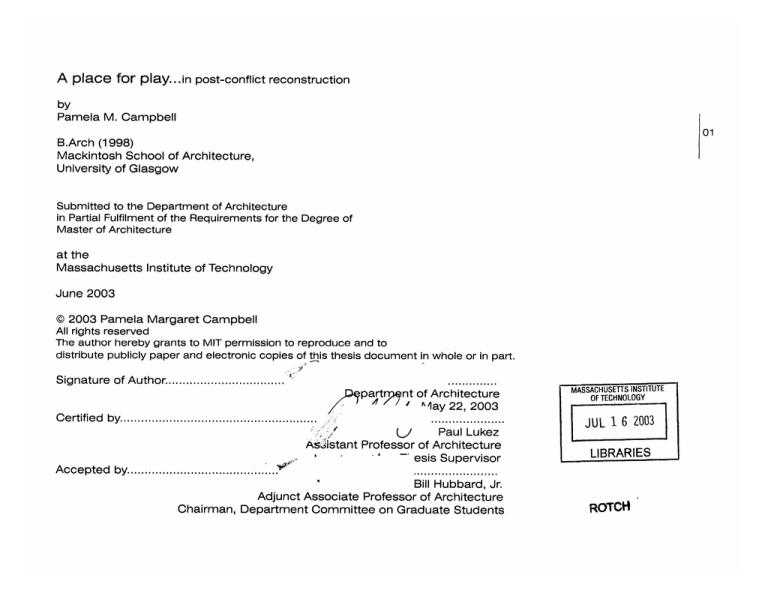
A place for play...in post-conflict reconstruction
by
Pamela M. Campbell
01
B.Arch (1998)
Mackintosh School of Architecture,
University of Glasgow
Submitted to the Department of Architecture
in Partial Fulfilment of the Requirements for the Degree of
Master of Architecture
at the
Massachusetts Institute of Technology
June 2003
@ 2003 Pamela Margaret Campbell
All rights reserved
The author hereby grants to MIT permission to reproduce and to
distribute publicly paper and electronic copies of this thesis document in whole or in part.
Signature of Author..................................
..............
partrPnt of Architecture
Certified by........................................................
01
22, 2003
I
4z'"lay
Paul Lukez
As istant Professor of Architecture
-.
Accented hv
Accented bv..............
MASSACHUSETTS INSTITUTE
OF TECHNOLOGY
esis Supervisor
Bill Hubbard, Jr.
Adjunct Associate Professor of Architecture
Chairman, Department Committee on Graduate Students
J
2003
16OUL
LIBRARIES
ROTCO
02
Julian Beinart
Professor of Architecture
Thesis Reader
John E. Fernandez
Assistant Professor of Building Technology
Thesis Reader
A place for play .......
in post-conflict reconstruction
by
Pamela M. Campbell
Submitted to the Department of Architecture
on May 22, 2003 in Partial Fulfillment of the
Requirements for the Degree of
Master of Architecture
abstract
Division within a city is commonplace, if not inevitable, whether geographically, politically, or by income,
race or ethnicity. The extreme environment of polarized cities therefore has a significant relevance within urbanism and the study of the built environment of cities in general.
The physical markers of dichotomization imposed on the urban landscape, whether in the form of
walls,
roads, fences or zones of vacant or patrolled land, become a significant presence and extremely meaningful element within the segregated city, and very much so in any future transformation or redevelopment of the
city. The question of how to deal with these physical manifestations of conflict and segregation is a key issue
within any post-conflict reconstruction and development within these cities, and is the main concern of this
thesis proposal. Belfast, in the province of Northern Ireland, is one such polarized city, with the Peacelines
manifesting the sectarian tensions between neighbouring communities and the conflict at large. These Peacelines, and surrounding interface areas are the site of this thesis, which attempts to deal with many of the issues associated with architectural intervention in, and the future possible urban morphology of the polarized
city, in a specific and complex urban situation.
Thesis supervisor: Paul Lukez
Title: Assistant Professor of Architecture
03
04
contents
background
research-the city
general
proposal_
site analysis
programming
site approach
project
conclusion
bibliography
acknowledgements
background
The broader area of concern that led to the initiation of this thesis is
that of the reconstruction of urban areas following a period of destructive
conflict. Within this very wide and unfortunately all too common phenomenon, there arises a distinct delineation, both in cause and effect, of the situations arising from a conflict due to external invasion from a party outwith
the country or state's borders, and those situations caused by an internal
or civil conflict. The latter case is of particular interest with regard to a prolonged pattern of the morphology, form and functioning, or malfunctioning,
of the city concerned due to the causes of the initial outbreak of violence
remaining to exist and effect the city on many levels beyond the perhaps
more confined timescale of the period of violent conflict and destruction.
In this specific subset of urban areas, or "contested cities" (Scott A
Bollens), where "ethnic and nationalist claims combine and impinge significantly and consistently at a municipal level" (Bollens), the urban area,
and public actions within it become saturated with ideological, ethnic and
nationalist meaning. There are in excess of forty protracted communal
conflicts in the world today (Gurr and Harff '94), and yet the architectural
profession's involvement in this area of research, in contrast with sociologists, political scientists, economists, geographers, journalists...... has
been very limited, and has in general confined itself to a very late stage
of invited involvement at a time when all conflict has at least superficially
subsided and it is deemed necessary to rebuild or reconstruct what has
been lost due to destruction. It is my concern that the late involvement of
architects, urban designers, and the design profession in general reduces
not only the scope of possible projects and approaches that may be applicable to the city in this condition, but also the broader successes that
may be achieved in the long-term resolution of the conflict within the city.
It is from this standpoint that my interest in contested, or polarized,
cities emerged.
uJ~~9r~
05
city divisions
Division within a city is commonplace, if not inevitable,
whether geographically, politically, or by income, race or ethnicity. I therefore see an attempt to work within the extreme environment of polarized cities as having a significant relevance within urbanism and the study of the built environment of cities in general.
beirut
berlin
/
jerusalem
There are many existing comparisons and attempts to define the
many contested cities that exist globally, such as the scale defining a
city's dichotomization devised by Benvenisti, which ranges cities from
mild and normal micro-level conflict over allocation of public resources,
through those which show macro-level dichotomy, to those in which
polarization has resulted in complete physical partition . In such cities as Berlin pre-1989, present day Nicosia, pre-1967 Jerusalem, there
has been examples of this complete partitioning, resulting in significant
changes in the physical form and functioning of the city. Today, Jerusalem, and Belfast in the province of Northern Ireland, represent extreme
examples of dichotomization, or segregation, while not completely spatially partitioned, combining many of the problems experienced by cities
ranged on the scale of dichotomization (Christofidou- 1986 MCP thesis).
The physical markers of this dichotomization imposed on the urban
landscape, whether in the form of walls, roads, fences or zones of vacant
or patrolled land, become a significant presence and extremely meaningful
element within the city, and very much so in any future transformation or
redevelopment of the city. The question of how to deal with these physical
manifestations of conflict and segregation is a key issue within any postconflict reconstruction and development within these cities, and is the main
concern of this thesis proposal, focusing on the "border", located geographically, temporally and politically, a place that Lebbeus Woods describes
as "the natural place for transformation....., where all kinds of systems
collide and abrade", as an approach to working within this environment.
nicosia
background
06
research
the city
b
/
My choice of the city of Belfast as a site for my thesis arises for
several reasons, such as accessibility and a certain amount of previous knowledge regarding the situation and place, but perhaps
more importantly due to it's status as a very under-studied environment with regards to it's present architectural and urban landscape.
Today, Belfast has left the most violent times of the troubles behind, and there has been significant improvement in the political,
economic and environmental situation in the past decade in comparison
with the long period of civil unrest following the outbreak of city-wide rioting
during the summer 1969, which resulted in the instigation of direct rule by
the British House of Commons in 1972. The peace process in Northern Ireland has been far from an easy path, however, with the devolved Northern
Ireland parliament at Stormont, established in 1998, being suspended again
only last October, a situation which is at present still awaiting resolution.
The city, in terms of it's demographics, economic situation, planning
and built environment, can be analysed and understood somewhat removed
from the more immediately unstable political status. This is due to Belfast's
inclusion within that category of cities experiencing ongoing inter-communal hostilities, the underlying causes of which are unlikely to be fully resolved
by any foreseeable political action. Through studying the city as a whole, I
have identified several characteristics and issues present in it's nature that
I believe have particular relevance with regard to any architectural proposal
that might be offered in relation to Belfast's border, or interface areas;
_segregation and the type, extent and location of the divisions
_density and the outward expansion of the city
_the changing character of the peripheral residential areas of the city due
to ongoing social housing stock renewal
_the dislocation of the peripheral residential areas from the character and
functioning of the city centre
_the restricted activities within the city due to the sectarian tensions
-the city's international image
07
division
The current demographics of
the population of Belfast show a highly
segregated situation particularly in the
peripheral areas of the city to the North,
East and West. This segregation has a
long history in the city and can be considered in a very simplified way as a division on religious and nationalist grounds,
between Catholic nationalists and Protestant unionists (the more extreme
forms of each side being referred to
consecutively as Republicans and Loyalists). Even before the riots of '69, 64%
of Belfast households lived on streets
with less than 10% of the other ethnicity.
Between '69 and '73, the conflict led to
60,000 residents being forced to leave
their homes, with 78% of households
living on segregated streets by 1977.
City-wide segregation and house
to house fighting led to the erection of
the 'Peacelines". These walls of varying
construction, height and length, were
initially built by the residents of the interface areas as make-shift barriers between the communities during the rioting
and were later built in more permanent
forms by the army. There are some 35
such peaclines in Northern Ireland, the
majority of which lie within Belfast, making the city an example of multi-sector
segregation rather than 2-sided partition.
V
08
Ae
religious distribution in
belfast
density
The interface areas surrounding
the peacelines have decreased in built
density significantly since the 1970's.
While large areas of the city centre and
docklands areas are undergoing redevelopment, with brownfield sites being utilized for dense mixed use developments
and many disused industrial buildings
and sites undergoing adaptive reuse
strategies for both commercial and residential purposes, the main arterial routes
out of the city centre and the surrounding
peripheral residential areas remain heavily underdeveloped and sparsely built.
09
Vo
mapping current built
density
"as a consequence of community division, significant areas of vacant
land with potential for development exist
along the Peacelines in Belfast and in
other areas."
(4.15: BMAP 2015 Issues Paper;DOE)
The nature and timing of this potential
development of the interface areas has
been a key concern of this thesis proposal.
O;f
1970's density of
study areas
housing stock renewal
The ongoing renewal of the social housing stock within these areas
has also contributed to the decreasing density of the city. The population
of the Belfast Metropolitan Area is currently 660,000 approx., around 20%
of which live in the most deprived areas according to the ward 'multiple
deprivation measure'. These areas mainly consist of government owned
social housing, with a concentration in the North and West of the city.
iffoXwN
Belfast Metropolitan Area
(BMAP 2015; DOE)
<K
The current projections by the Department of the Environment for
Northern Ireland state that 51,000 new houses are required in the BMA
by 2015, with a regional target of 60% to be accommodated within the
existing urban area. Although this brown field use strategy is being employed in part, an article in Fortnight Magazine (Alan Jones,January
2003) titled 'Making a Mess of the City" states numerous examples of
the nature of the enforcement of this policy. In Donegall Pass in the centre of Belfast, 2400 houses were knocked down and replaced by 650
social and 200 private dwelling units, and similarly in the Willowfield
area of the city where 515 perfectly serviceable terraced houses were
cleared with only 275 to be put back, with the original residents being
relocated to more remote peripheral centres of the metropolitan area.
This de-densification can in part be attributed to central mismanagement of the urban housing situation, but is also heavily effected by
the preferred housing types and estate layouts, a choice very much
influenced by the segregated nature of the city. While the Peacelines
constructed of iron fences, brick or concrete walls, etc., can be demolished in a day, the defensive nature and security forces access requirements designed into the newly constructed estate layouts are
less easily manipulated, built very much with sectarianism in mind.
Belfast now is therefore at a threshold, where not only is it in danger of
spreading outwards to the surrounding green field environment, thus destroying one of the cities majorresources, but is also headed towards an urban landscape of homogeneous and long-term defensively planned housing estates.
the cIty
10
dislocation
Belfast City centre
The Cathedral Quarter
Entering east tieirast
The Crumlin Road
Lanan
gates
There has been much criticism of the Belfast Metropolitan Area Plan
with regard to the deprived residential areas to the North, East and West of
the city, with it's "top-down approach" not recognising the urgency in these
areas. "It is essential that people in both areas should begin to see meaningful action as quickly as possible" (West Belfast and Greater Shankill Task
Force Report Feb 2002). This organization is also intent on enhancing the
mobility of the residents in the concerned areas, facilitating job seeking
outside the immediate area, which is at present limited due to the extreme
nature of the segregation and sectarian tensions. This lack of dynamic interaction of the city's poorer areas with the city centre and each other, not
only disrupts the city's overall natural morphology in terms of demographic
flows and it's economy, but adds significantly to the lack of communication
and understanding between the two conflicting sides. " Any ethnic group,
and that is particularly true in the working class areas of Belfast, usually
succeeds in creating and maintaining a comprehensive set of ethnic institutions; religious, educational, political, recreational, etc.....preventing
them (it's members) braving contact with the rest of the community,
or at least making such contact unnecessary" (Civil Unrest, PRDU '93).
In such situations where this organizational and institutional completeness is quite high, and particularly in the case of Belfast where communities have always been self-segregated, any strategy that might seek
to integrate or homogenize the city's population and identity is brought into
question. The project then becomes a question of how to begin to instigate
a dynamic relationship between the segregated areas of the city, and with
the city centre, while recognizing and not opposing the existing divisions,
and the often extreme importance placed by the population on these divisions and ethnic differences. The viewpoint that the population's segregation and the division of the city might not be regarded a problem to solve,
but rather a starting point and guide for a future development and morphology of the city in a positive light, is key aspect of the understanding of this
proposed project.
11
resctricted activity
In a city so effected by sectarian
tensions as Belfast, the behaviour of it's
population within the public realm obviously is coloured to a greater or lesser
degree by these tensions. In the city
centre of Belfast, it extremely difficult
for the majority of the time any sign of
such an occurrence. It is only when looking at the population's behaviour with
regard to certain public activity that
we realise the great difference here.
When looking at aspects of a
population's public activity that require
a declaration of any strong sentiment
that may be construed as an endorsement of either side of the conflicting
parties, we see that here some behaviour inherent and natural in many other
populations has taken on a significance
beyond it's literal meaning. Examples of
this range in the city from the display of
colour, the supporting of a sports team,
or even a sport itself, to more verbal issues, such as declaring ones attachment
to their home, their street, their community, or even their country, in a place
where the very legitimacy of the country
they are in fact a part of is in question.
These issues are all related to the
nature and public display of a personal
aswell as a more collective identity.
12
image
y\.,ou beleved what you read in
the papers,' he said 'you'd think
civil var w'as raging everywhere
in Northern Irelanc But if you
iveU here, and you think of the
truDIos, YOU think of it as hap-
pe nig in cert ain towns. And if
you Kve In those certain townis,
you think of it as happeniiig in
ertaii districts. And if you live
in those certain districts, you
tinik of it as happening oini certainI housng estates.
Ainu_! if you lve on those certain
i i estates, you think of it
,is n ppeuiing in certain streets.
An0 If you live in those cortail
streeits. you kiiow that the trou-
lie is nein g caused by the man
at the end of the road in the
I ouse with the blue door.'
W are aLl iii the hOuse with the
er
o
ioeBldfist
2008 bid)
In January of this year, it was announced that Belfast had failed to
reach the final short-list for nomination as European City of Culture 2008.
In competition with other UK cities such as Birmingham, Cardiff, Liverpool,
Newcastle, Bristol and Inverness, Belfast had probably the least recent
investment in projects that would be likely to convince the jury of their
case, but also had by far the most to gain from the potential large economic investment and increase in tourism that is associated with this title.
"Further potential exists, however, to improve the international
image of the city and improve it's attractiveness to visitors."
(BMAP 2015; DOE)
This massive understatement from the BMAP issues paper alludes to a
major concern and focus of resources at present in Belfast- that of tourism, and the yet to be achieved potential of the city to be ranked as a major tourist destination amongst the "league of European cities." The past
decade of development in the city centre and the docklands area, such
as the Odyssey centre (with arena, multiplex cinema, interactive science
museum, shops), are certainly steps taken towards a tried and tested
strategy of the redevelopment of many post-industrial cities, particularly
within the UK. What such a strategy does not address beyond the potential
benifit to the city as a whole in economic terms, is the nature of that city
and its population from a viewpoint of what is unique rather than what has
the potential to be like and function like other cities. In this light, it seems
that if Belfast had managed to gain the title of European City of Culture
and the initiation of projects in relation to this, it would have been largely
a leap in a direction I believe not to have been fully considered, and which
would have missed many opportunities inherent in the city at present.
The present condition of the social housing estates of the city have
little effect on this area of discourse at present, and yet their 'image' both
within the city and externally surely have to be included within the city's
overall perceived image. Within this thesis project, it has been my concern
to add this unheard voice to this larger discourse, within the theme of communication in general within the interface areas.
the city
13
research
general
7r~
70~7
L)
In 'Collage City', Colin Rowe speaks of the elements and patterns,
and their morphologies, that constitute 'the city' through an investigation
of many examples. One aspect of this work that particularly resonated with
the theme of 'border' and urban thresholds is his identification of composite
or 'hybrid' buildings. Although all are historical examples, they within their
form and siting encompass a building typology that reacts to and mediates
the two very different urban patterns and scales that lie either side of them.
In Belfast, as mentioned, the peripheral housing estates are at present
in a state of flux due to ongoing housing renewal. There exists, for now, a
detectable difference between the housing of the two different communities in many interface areas, beyond the existence of the wall, or peaceline,
largely due to the fact that in most cases housing renewal has proceeded
faster within the majority Catholic housing estates, no doubt for political
reasons. This has, however, brought about a physical, recognisable difference between the built form within the territory of each community. Within
this coincidental occurrence lies a potential guide for a possible alternative
future morphology of these areas, in opposition to the seemingly inevitable
progress of the renewal project in a indiscriminating and homogenous way.
The idea of the introduction of a two-sided or hybrid building into
a landscape to encourage future diversification of building form either of it's sides, is in some ways the reverse in terms of sequence
and timescale of what Rowe identified in his writing. Such a strategy
may, however, result in a similar identification of change, border and
threshold that these historical examples represent. This two-sidedness or duality became a function of this project for the interface areas.
14
..
.........
.......
I....
.
............
WIN"
..............
district cities
In continuing the line of investigation into
the nature of thresholds within existing cities,
rather than continuing to react to comparable
precedents of divided and segregated cities,
with their various projects focused around the
nature of the division very much with the immediate reconciliation of two opposing sides
as primary motives, to look at cities unrelated
to this specific phenomenon gives us a broader range of typologies of the urban threshold.
The idea of 'district cities',
where there are clearly identifiable separations within the city's fabric, function, population, economy and at times politics, represents a more varied model for a possible
future transformation of the city of Belfast.
The city of Paris constitutes many areas
varied in historical indigenous resident population, trade and interrelationships with other
areas, that while changing in nature to this day,
are still identifiably different, without necessarily relying on historicism or conservation to
retain these distinguishable characters. One
distinctive type of threshold within this city are
it's boulevards. Although a constructed, very
controlled intervention into the cities fabric,
they today function as not only identifiable elements themselves, but aid the recognition of
the crossing of a threshold from one district to
another that lie behind the ordered facades of
the boulevard.
15
/
researc h
16
proposal
proposal
general
Through
identifying twelve sites
throughout the city of Belfast that exhibit the major elements transcribed
onto the urban fabric of the effects of
the nature and history of the segregation
and general situation in the city, such us
a reduction in the density of built form,
a physical presence of separation
in the form of a peaceline of some
type, amidst the ongoing
17
k
MAO
progress of the housing
renewal strategy, I have
formed a potential network
of projects that can act in
conjunction with each other to
form a simultaneous, city-wide
proposal.
This network has taken on different
meanings and phases through it's application to the various elements of the developing project. Foremost, it represents
a linking of, and dynamic relationship between, the areas of the city currently existing in a state of stagnant isolation from
each other and the rest of the city. The
instigation of a programmatic element, in
this case the actual construction of the
architectural intervention itself at the border/ interface areas, that has a recognisable, visible presence on each of these
nodes along the network, is intended to
begin one form of linkage and interaction.
6
n
i_
site analysis
The three sample sites, one to
the north, one to the east and one
to the west of the city show a variety of forms of the division between
communities and related physical
consequences of the segregation.
'I -
The existence of vacant land at the
interface between the two communities
in each case provides a site for possible nort
intervention, but also the opportunity for
the introduction of a building form and
construction type that could influence, in
form, materials, and density, the possible,
and mostly probable near future development of the areas either side of this zone.
Where the line of division is at
present in each case occupied already
by a built form (that of a peacline), it is
the area either side that becomes the
site if we are to presume that the current eas1
situation does not allow for the removal
of the peaceline at present.
With the model of the 'boulevard'
in mind as a two-sided element constructed by the built form either side of
it, as it acts as the marker of a threshold and container for districts behind
it's walls, the siting of element in these
situation, that attempt to act in a similar
way, can be projected through stages of
possible development.
18
~lllll|1
II
II
Ii""
-6*
wes
il~
|||I
III
II
111111
\~\
~Ii
111111
programming
The project is intended to enable the three network diagrams adjacent to function at the level of the
three main elements of the design:
W
19
7
the support/structural spine that forms
the permanent delineation of the side
edges of the peaceline zone, as the initiation of the future boulevard.
the playroom that forms the head condi- network_1
tion of this spine, reacting to the specific
conditions in each case of where the
boulevard ends and addresses the surrounding existing street patterns.
the accumulative units that become the
inhabitation of the spine and initiate the
functioning of the boulevard as a public
commercial street.
network_1 represents the rotation
around the sites of the equipment/ machinery required for the construction
of the buildings, both initially and then
through the continuing requirement for
their services for the successive units built
network_2 represents the importing to the sites in the form of
labour and machinery for this construction, and also in the form of spe-
cialist in the various fields of 'play' to
be accommodated within the playroom
network_3 represents the exporting
from the site, both of goods, and of infor-
mation in both audio and visual forms.
-
A.
20
the building systems and components that constitute the interior of the spine, it's enclosure,
and the accumulative units are manufactured and constructed on-site, using the activity,
commerce and possibility for skills training as part of the programming within the project.
the activities within the playroom would be initiated through a program organizing a collaboO
C
ration between each playroom, and the surrounding community, and existing institution in
Belfast's city centre. the range of activities shown are examples of programmes that combine
the possibility for a competitive atmosphere to be encouraged, while being of a nature where
it is able to achieve a certain degree of recognition and broader respect for achievement
within
that activity. this element of the program is partially in reaction to the identification of
O
that characteristic of the city where, certain activities being restricted in the public realm,
results in a current lack of display of competitive activity and passionate involvement in an a
place, activity, or people
CO
0.
0
0
XI
using the existing surveillance
infrastructure as part of the
unique nature of these interface sites, I propose that the
initial construction, progressive development, and programmatic events could be
broadcast to a larger audience
the existing security communications network is also adapted
as part of a civilian radio network, each site having it's own
station and broadcast frequency, with the potential for a future
amalgamation, as part of the
narrative of the network of sites
site approach west
At one of the major crossing points of the
longest peaceline that
runs west of the city centre for approx. three kilometres, there exists a security gate at present. The
surrounding vacant land is
at present unusable due to
it's proximity to this border.
Taking the line of a
previously existing road,
the boulevard is formed by
the buildings on alternate
sides of the peaceline,
creating a crossroads,
with the playroom/head
elements
marking
this point of threshold
21
site approach east
In the predominantly Protestant East
Belfast, there is an estate
of isolated pro dominantly
Catholic housing, Short
Strand, contained by a
high brick wall almost entirely encircling the estate.
Adjacent to the entry to this estate, there is a
large vacant area of land,
and opposite, on the estate
side of the road is a large
area currently occupied by
a bus depot. taking these
two site that straddle a
through road currently not
used by pedestrians due
to this nature of its location, part of this existing
road is adopted and characterized by the placing of
the buildings either side,
creating a slow zone on
the road marking the different territory either side
of the road, while creating a possible future pedestrian link between the
entrance of the estate and
the busy commercial area
further along the road.
22
23
project
,x-11111111111111111111111111111-
24
--
T
-
4
-4
~1
I
T~WK
U
I-
-L
'41
K
Cliftonpark area location
plan
~~,'7
-,
-1,-i [
'
'
*
-
'1<
K-f--i.
44
U1
K
,
2
-
II
41 i
I
-
-'4
-4
Li
4
-::
T,
r-
4,-
-T
-4
+ site Plan
site approach north
link road
playroom
support spine
pedestrian street
peaceline
support spine
playroom
link road
The site is located to the north of the
city, and runs between
two link roads from the
Crumlin Road to the
south to Cliftonville Road
to the north along the
line of the peaceline.
The proposed pedestrian street would run
between these two link
roads, between two areas of housing that lie
beyond vacant land, secured by a fence, either
side of the peaceline.
The head containing
the playroom and the radio station forms the start
of the street at either end.
25
26
1lo
first floor plan
AL-1 dJi
Lift tPIfn,
/
~
f~j~ ~
~ I
*1
I
f~ 1~2L71F~>J
~1'
7>
I
ground floor plan
tT
U
j
4
first floor plan
27
*~~
Ti*-
south elevation
P~EUP
I
1
IJ
4,
v
4.i
7
I4
I
E
I
f
I
I
I
south street elevation
n r
r
north elevation
present ati o v
unit types
28
tKf
office unit
manufacturing
housing
I
fraiA
~~4j-i~f1i
_____
I
I:
~
north street elevation
K
7
I
shop
IF
I
I
i
I
I
II
f
I
I
___________
29
playroom cross section
playroom long section
30
cross section1
cross section 2
cross section 3
31
cross section_4
cross section_5
.
.
.............
r
32
HJillv
I
r7~
support/ structural spine and playrooms constructed
~pi
I
T
-I
_____
-- 4
unit 1 constructed and fabric wall manufactured
the above constitutes phasel: funded jointly by the British government (DOENI), the local council, national lottery heritage fund, and up to 50% by the EU Peace and Reconciliation fund.
Ownership and organization of this structure would be held by each adjacent community under the administration of the Belfast Interface Organization, but with the land remaining under the ownership of the
relevant public/governmental body
..........................................................
.............................
33
zz
-~
A
---- -
accumulation of units
.11--I
-
1
IAM
TAM,
I
-j
eventual removal of peacewall
the spine of the building functions as a small business incubator, with relevant support space and advice centre, and the units are built as required. While businesses own their own unit, their space/services
rental from the spine in part funds the programming of the playroom. The mixed use and ownership is
intended as an initiator for an naturally evolved streetscape, instigated in preparation for the future use of
the interface zone.
f c yC
I
construction
The regular bay system of the spine
relates in scale and fabric to the surrounding area, while being more dense
and continuous, resembling the former
row houses and terraces, rather than
the newer semi-detached cul de sacs.
The variation in the heights and possible
circulation schemes allow usage by a
variety of future inhabitants and trades.
The choice of a fabric wall system
for the enclosure is relevant on several
levels. As an easily manipulated fabric
and having a translucency and lightweight nature, the perception of this
linear element is intended to be different than that of the existing peacewall,
while essentially clarifying the territory either side as is the function of the
peacewall. It's ability to change easily,
revealing the nature and variety of occupation behind, while still being economically comparative with other cladding options, has several advantages.
34
typical arcade bay
The structural role of the fabric,
which acts not only as an enclosure, but as
part of the superstructure in the building's
initial phases of usage, is that of crossbracing for each bay and provides lateral
stability for the whole length of the spine.
Li
J
typical shop front bay
35
1 fin walls
constructed in initial phase of building
with playroom/ radio station
4_unit 1
manufacturing of brace fabric and
internal finishes and fittings
2 fin frames
3_wall structure
structure for floors and ceilings
constructed in phase 1
superstructureb for fabric brace wall
constructed in phase 1
5_unit brace walls
6_multiple units
successive units built, each providing
lateral bracing for wall structure
bracing provided by units renders
fabric skin redundant/removeable/
changeable
C 0f
S
--
_
36
partial elevation of batten guides for openings
-
detail of fabric/steel joint
2
detail section closed
37
O1f
4
is
detail section open
plan detail of wall
COn1StruliO 1
steel fibre fabric reinforcement
layout options
38
two layer option
39
removed panels
after unit construction
inner ETFE
transparent
skin
insulation
pockets
2_layer laminate
fabric skin
V
-- brace
omentwallframe
self-supporting
unit construction
con struct ion
conclusion
There is an ongoing need for
the architectural profession to identify
and engage themselves in new areas
where it may have had little or no participation in the past. The discipline of
architecture, if it is to be sustained as
a viable profession must seek those
contemporary situations where it can
make a relevant and valuable contribution. I believe civil conflict is one such
area, and that it should be the profession that sets its agenda for involvement,
not a competition committee or NGO.
Within this thesis I have attempted
to address some of the pressing issues
with regards to this area of study where
architecture and urban design are very
much relevant, such as the question of
how architecturally we can define territory and thresholds in a contested environment, what the appropriate timescale
and duration of such an intervention
might be, and how to make a meaningful architectural proposal without
relying on historicism or modes of memorialization for impotus or justification.
I hope my small contribution to
and thoughts on this issue have some
relevance to a broader picture of an
unfortunately
widespread
situation.
40
bibliography
Urban Triumph or
Urban Disaster
Esther Charlesworth, John Calame
(PRDU)
Civil Unrest shaping the
Built Environment
in
Norther Ireland
Sultan Barakat (PRDU)
Aesthetic Occupation:
the immediacy of architecture
and the Palestine Conflict
Daniel Monk
Urban Peace-Building in
Divided Societies
Scott A. Bollens
On Narrow Ground: Urban
Policy and Ethnic Conflict
in Jerusalem and Belfast
Scott A. Bollens
Urban Social Segregation
Ceri Peach
Shaping a City: Belfast in
the late 20th century
Frederick W. Boal
Voyage
Nadim Karam and Atelier Hapsitus
BorderLine
RIEAeuropa
Editors Lebbeus Woods, Ekkehard
Rehfeld
Pamphlet Architecture 15
War and Architecture
Lebbeus Woods
Projecting Beirut
Hashim Sarkis
Silver Linings; travels
around Northern Ireland
Martin Fletcher
BMAP 2015 issues paper
Department of the Environment
oneBelfast
Belfast 2008 European Capital of
Culture bid
A Landscape of Events
Paul Virilio
41
The Activist Drawing; retracing
situationist architecture from
Constant's New Babylon to beyond Catherine de Zegher and Mark Wigley
The New Intifada; Resisting
Israel's apartheid
Edited by Roane Carey
Warped Space; Art, Architecture
and Anxiety in Modern Culture
Anthony Vidler
Critical Inquiry, Spring 1997
Front Lines/ Border Posts
Laying Claim to Beirut, Saree Makdisi
West Belfast and Greater
Shankill task Force Report
February 2002
Chairman; Padraic White and John Simpson
Information exchange:
How cities renew, rebuild, and remember
42
Van Alen Institute
Sport, Nationalism,
And Globalization
Alan Bairner
Nicosia: The divided capital
Of Cyprus
MCP Thesis; Elena Christou Christ )fidou
websites
http://cain.uIst.ac.uk/images/maps/maps.htm
Cain maps of Ireland
http://www.economicstatistics-ni.gov.uk/keyfacts/index.asp
Department of Enterprise Trade and Investment
http://www.hlf.org.ukfindex2.html
Heritage lottery fund
http:/www.northbelfastcommunityactionproject.org/report/appendixc.htm
Northern Ireland Community Action Project
http://www.nics.gov.uk/eu/eussppr/progsumm/
EU Peace and Reconciliation Programme
http://www.ukbi.co.uk
UK Business Incubation
http://www.northsails.co.uk
Northsails Yacht sail manufacturing
ID~h~- -1Dr q
acknowledgements
Firstly I would like to thank my
committee members for their advice, encouragement, time and support over the
past four months. Also, my thesis classmates, Rye Konishi, Shaohua Di and Leonardo Bonanni, for helping make the
past four months in a tiny studio space
as enjoyable and stress-free as possible.
In Belfast I would like to thank Ciaran
Mackel, architect, for his time and patience
with all my questions, the staff and the Linnenhall and Central Libraries, and Briege
and Kevin Chalmbers, for their advice and
hospitality during my first visit to Belfast.
Thankyou to Andrew Marcus and Jason
Hart for much appreciated presentation help.
Lastly, my
parents
and
sister Barbara, for all their support, extreme patience, continual phone calls,
postcards,
newspaper clippings, etc.
etc. over the past three years, thanks.
43



